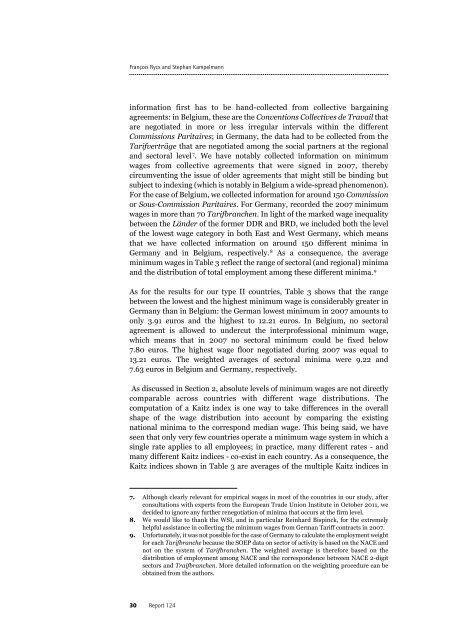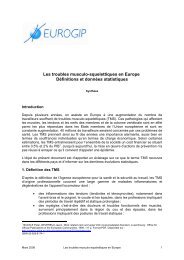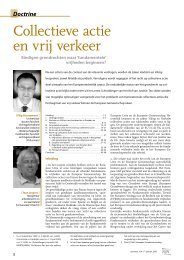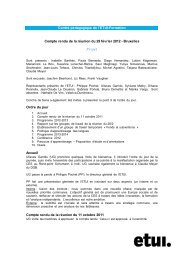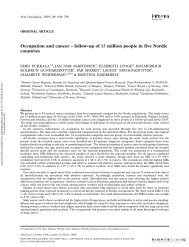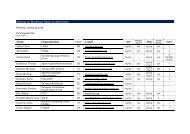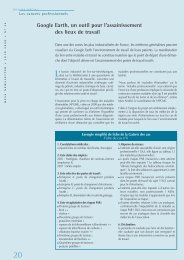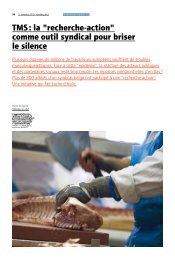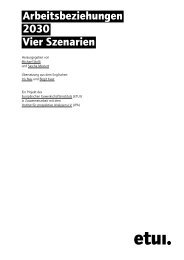Who earns minimum wages in Europe - European Trade Union ...
Who earns minimum wages in Europe - European Trade Union ...
Who earns minimum wages in Europe - European Trade Union ...
You also want an ePaper? Increase the reach of your titles
YUMPU automatically turns print PDFs into web optimized ePapers that Google loves.
François Rycx and Stephan Kampelmann<br />
<strong>in</strong>formation first has to be hand-collected from collective barga<strong>in</strong><strong>in</strong>g<br />
agreements: <strong>in</strong> Belgium, these are the Conventions Collectives de Travail that<br />
are negotiated <strong>in</strong> more or less irregular <strong>in</strong>tervals with<strong>in</strong> the different<br />
Commissions Paritaires; <strong>in</strong> Germany, the data had to be collected from the<br />
Tarifverträge that are negotiated among the social partners at the regional<br />
and sectoral level 7 . We have notably collected <strong>in</strong>formation on <strong>m<strong>in</strong>imum</strong><br />
<strong>wages</strong> from collective agreements that were signed <strong>in</strong> 2007, thereby<br />
circumvent<strong>in</strong>g the issue of older agreements that might still be b<strong>in</strong>d<strong>in</strong>g but<br />
subject to <strong>in</strong>dex<strong>in</strong>g (which is notably <strong>in</strong> Belgium a wide-spread phenomenon).<br />
For the case of Belgium, we collected <strong>in</strong>formation for around 150 Commission<br />
or Sous-Commission Paritaires. For Germany, recorded the 2007 <strong>m<strong>in</strong>imum</strong><br />
<strong>wages</strong> <strong>in</strong> more than 70 Tarifbranchen. In light of the marked wage <strong>in</strong>equality<br />
between the Länder of the former DDR and BRD, we <strong>in</strong>cluded both the level<br />
of the lowest wage category <strong>in</strong> both East and West Germany, which means<br />
that we have collected <strong>in</strong>formation on around 150 different m<strong>in</strong>ima <strong>in</strong><br />
Germany and <strong>in</strong> Belgium, respectively. 8 As a consequence, the average<br />
<strong>m<strong>in</strong>imum</strong> <strong>wages</strong> <strong>in</strong> Table 3 reflect the range of sectoral (and regional) m<strong>in</strong>ima<br />
and the distribution of total employment among these different m<strong>in</strong>ima. 9<br />
As for the results for our type II countries, Table 3 shows that the range<br />
between the lowest and the highest <strong>m<strong>in</strong>imum</strong> wage is considerably greater <strong>in</strong><br />
Germany than <strong>in</strong> Belgium: the German lowest <strong>m<strong>in</strong>imum</strong> <strong>in</strong> 2007 amounts to<br />
only 3.91 euros and the highest to 12.21 euros. In Belgium, no sectoral<br />
agreement is allowed to undercut the <strong>in</strong>terprofessional <strong>m<strong>in</strong>imum</strong> wage,<br />
which means that <strong>in</strong> 2007 no sectoral <strong>m<strong>in</strong>imum</strong> could be fixed below<br />
7.80 euros. The highest wage floor negotiated dur<strong>in</strong>g 2007 was equal to<br />
13.21 euros. The weighted averages of sectoral m<strong>in</strong>ima were 9.22 and<br />
7.63 euros <strong>in</strong> Belgium and Germany, respectively.<br />
As discussed <strong>in</strong> Section 2, absolute levels of <strong>m<strong>in</strong>imum</strong> <strong>wages</strong> are not directly<br />
comparable across countries with different wage distributions. The<br />
computation of a Kaitz <strong>in</strong>dex is one way to take differences <strong>in</strong> the overall<br />
shape of the wage distribution <strong>in</strong>to account by compar<strong>in</strong>g the exist<strong>in</strong>g<br />
national m<strong>in</strong>ima to the correspond median wage. This be<strong>in</strong>g said, we have<br />
seen that only very few countries operate a <strong>m<strong>in</strong>imum</strong> wage system <strong>in</strong> which a<br />
s<strong>in</strong>gle rate applies to all employees; <strong>in</strong> practice, many different rates - and<br />
many different Kaitz <strong>in</strong>dices - co-exist <strong>in</strong> each country. As a consequence, the<br />
Kaitz <strong>in</strong>dices shown <strong>in</strong> Table 3 are averages of the multiple Kaitz <strong>in</strong>dices <strong>in</strong><br />
7. Although clearly relevant for empirical <strong>wages</strong> <strong>in</strong> most of the countries <strong>in</strong> our study, after<br />
consultations with experts from the <strong>Europe</strong>an <strong>Trade</strong> <strong>Union</strong> Institute <strong>in</strong> October 2011, we<br />
decided to ignore any further renegotiation of m<strong>in</strong>ima that occurs at the firm level.<br />
8. We would like to thank the WSI, and <strong>in</strong> particular Re<strong>in</strong>hard Bisp<strong>in</strong>ck, for the extremely<br />
helpful assistance <strong>in</strong> collect<strong>in</strong>g the <strong>m<strong>in</strong>imum</strong> <strong>wages</strong> from German Tariff contracts <strong>in</strong> 2007.<br />
9. Unfortunately, it was not possible for the case of Germany to calculate the employment weight<br />
for each Tarifbranche because the SOEP data on sector of activity is based on the NACE and<br />
not on the system of Tarifbranchen. The weighted average is therefore based on the<br />
distribution of employment among NACE and the correspondence between NACE 2-digit<br />
sectors and Traifbranchen. More detailed <strong>in</strong>formation on the weight<strong>in</strong>g procedure can be<br />
obta<strong>in</strong>ed from the authors.<br />
30 Report 124


